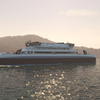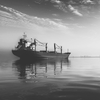Despite what could be best termed as difficult operating conditions, the German maritime market has persevered through its collective adherence to the principles which propelled it to the lead of the maritime construction and outfitting markets: a steadfast adherence to producing technologically correct and advanced vessels, products and systems.
The challenges facing the German maritime market are not unlike those facing many of its European colleagues and competitors, or those facing industrial operations in any of the world's leading economies. The proliferation of lower-cost shipbuilding, ship repair and marine equipment supply options outside of Europe, particularly in Asia, has led to a significant drain on business emanating from and dollars flowing to the German homeland. At the same time, the German industry continues to fiercely clutch the niche of high-quality vessel owners and operators, those that have come to expect and rely upon the technical excellence and operational reliability of maritime products that are made in Germany.
One such niche is the cruise ship industry, which Papenburg-based Meyer Werft has been a competitive force within for years. The cruise ship building process at the company's covered facility is nothing short of amazing, with three ships in various stages able to be built simultaneously in a relatively compact space. The yard is currently building Radiance of the Seas, Superstar Libra, Aurora, Superstar Virgo and Superstar Scorpio. Apart from its cruise ship building prowess, Meyer Werft has strategically positioned itself for prosperity well beyond 2000 -- which is a positive development considering the recent newbuild orders for cruise ships filtering to Asian shipyards.
Recently the second gas tanker for Norwegian shipowner -- a notoriously quality-minded group -- Sovang ASA was named Clipper Harald. The 480 x 67 ft. (146.4-m x 20.5 m) gas tanker have a cargo tank volume for 12,660 cu. m. and a speed of 18 knots. In addition to ethylene, the ship is able to carry vinyl chloride momomer, ammonia and propylene oxide in three bilobed tanks. The capability of carrying different liquefied gases at a temperature of down to minus 104 degrees C makes the tanker one of the most modern of its kind.
Clipper Harald is the result of a cooperation between Thyssen Nordseewerke of Emden and Meyer Werft Shipyard, giving the two companies a very positive reference in a highly competitive market that is controlled by shipyards in the Far East.
The cruise market has brought recent good fortune to another German shipyard -- Lloyd Werft Bremerhaven -- which was recently awarded a contract by Cunard Line, Ltd. for the refurbishments aboard Queen Elizabeth 2, Vistafjord (to be renamed Caronia) and Royal Viking Sun (to be renamed Seabourn Sun. Specifics of the contract were not disclosed, but it is estimated that the re-design and upgrading of the three ships, including technical work and exterior maintenance and re-painting, will approach $34 million. "The unusual scope of the work dictated a yard with extraordinary capabilities and focus," said Cunard president and CEO Larry Pimentel. "There are considerable advantages for us, as well as for Lloyd Werft, to have all three of these ships in the same shipyard at roughly the same time. From our position, having all three ships at one yard makes it easier for our marine and technical staff to liaise with Lloyd Werft and monitor the work on a day-to-day basis."
Lloyd Werft is no stranger to Cunard or the Queen Elizabeth 2, as the company has carried out work on the ship in 1983 and 1984, and carried out the complete overhaul and conversion of the vessel during a 179 day period spanning 1986 into 1987.
Another German yard that has maintained success in a technical specialty is the Flender Werft AG yard in Lübeck. The latest in a line of outstanding containerships delivered by the yard is newbuilding no. 671, MV Santa Fabiola, delivered to Hamburg based shipowner Claus-Peter Offen. The vessel will be called P&O Nedlloyd Singapore, following a timecharter to P&O Nedlloyd.
The ship is the fifth of the Flender 2100 type (F-class) commissioned by Claus-Peter Offen, and is known for economical and optimized stowage of a large capacity while maintaining low fuel consumption numbers. The 30,200-dwt vessel, which measures 601 x 97.9 ft. (183.2 x 29.8 m) with a 37.8-ft. (11.5-m) draft is classed by GL. It is outfitted with four cranes, two of which have a 45/50/36-ton lifting capacity each, while the other two have a 35/30-ton lifting capacity each. The holds are fitted with 40-ft. cell guides, and 2,169 containers can be stowed in six tiers on deck and in the cargo holds. The upper deck is equipped with 420 plugs for the reefer containers.
Powered by a longstroke MAN B&W 6S60 MC design, rated 12,240 kW at 105 rpm, the ship has a speed of 20 knots.
Kiel-based Lindenau extends the German province of specialty ship construction by specializing in the production of specialty double hull oil and chemical tankers up to 40,000 dwt. The medium-sized yard, located at the entrance of the Kiel Canal, has a tradition of forming long-term relationships with high-value clients, working closely with them to deliver vessels that meet exacting specifications. Apart from the oil and chemical tankers, the yard is an able competitor in a wide range of vessel development, design and construction, from orange juice, molten sulfur and phosphor acid carriers, to RoRo vessels, containership and passenger vessels. Although the repair business has largely vacated Northern Europe, the yard is positioned for such work
Two German companies -- Krupp Fordertechnik GmbH and Thyssen Nordseewerke -- recently completed the first construction phase of the largest trailing hopper dredger. With the first bottom section, the keel of the jumbo dredger was laid on the slipway of Thyssen Nordseewerke yard at Emden the end of last April. The company, along with its partner Krupp Fordertechnik GmbH, has been working on the newbuilding for the past year. Scheduled for delivery at the beginning of 2000 to Jan de Nul group of Belgium, the dredger measures 656 ft. (200 m), with a 118.7 ft. (36.2 m) breadth and 33,000 cu. m hopper capacity. With 36,000 kW installed power for speeds of 16.5 knots, Vasco da Gama will be used mainly in land reclamation.
Maintaining The Edge
It is no secret that the German maritime industry has earned the respect of the international maritime community for its high quality of product and service. Earning and maintaining such a reputation, however, comes only through dogged pursuit of devising increasingly innovative and effective solutions to the many challenges presented by the rugged maritime environment. Advanced work in the areas of Research and Development is perhaps best embodied by the continued efforts of classification society Germanischer Lloyd (GL). GL, led by Dr. Hans Payer, continues to make impressive strides in many different areas of the maritime realm, with the goal of each project firmly entrenched in the "real business" side of enhancing maritime efficiency and safety. Most recently, GL launched project WaveLoads, which will be an advanced method for predicting wave induced loads for high speed ships. In announcing the project, GL said that to ensure their competitive positioning world markets, European shipyards need to be able to produce modern high speed ships that conform to the highest safety standards, while operating in the increasingly congested waters, which have become the hallmark of European short sea shipping routes. GL commented that classification society rules provide formulas for safe design loads, but they tend to reflect the service experience of existing ships and will not adequately account for future larger scale ship designs. The three-year Waveloads project is scheduled to culminate in the establishment of guidelines and recommendations for hull structural improvements and hull developments for high speed ships.
Subscribe for
Maritime Reporter E-News
Maritime Reporter E-News is the maritime industry's largest circulation and most authoritative ENews Service, delivered to your Email five times per week










